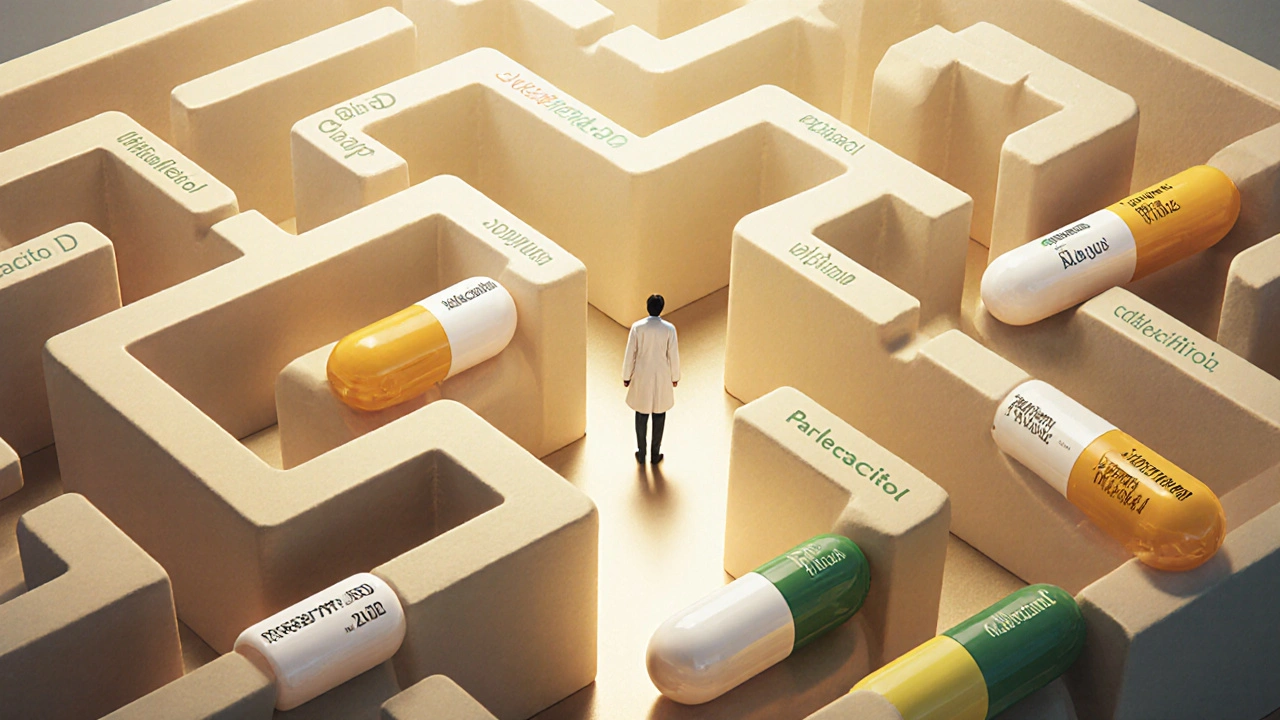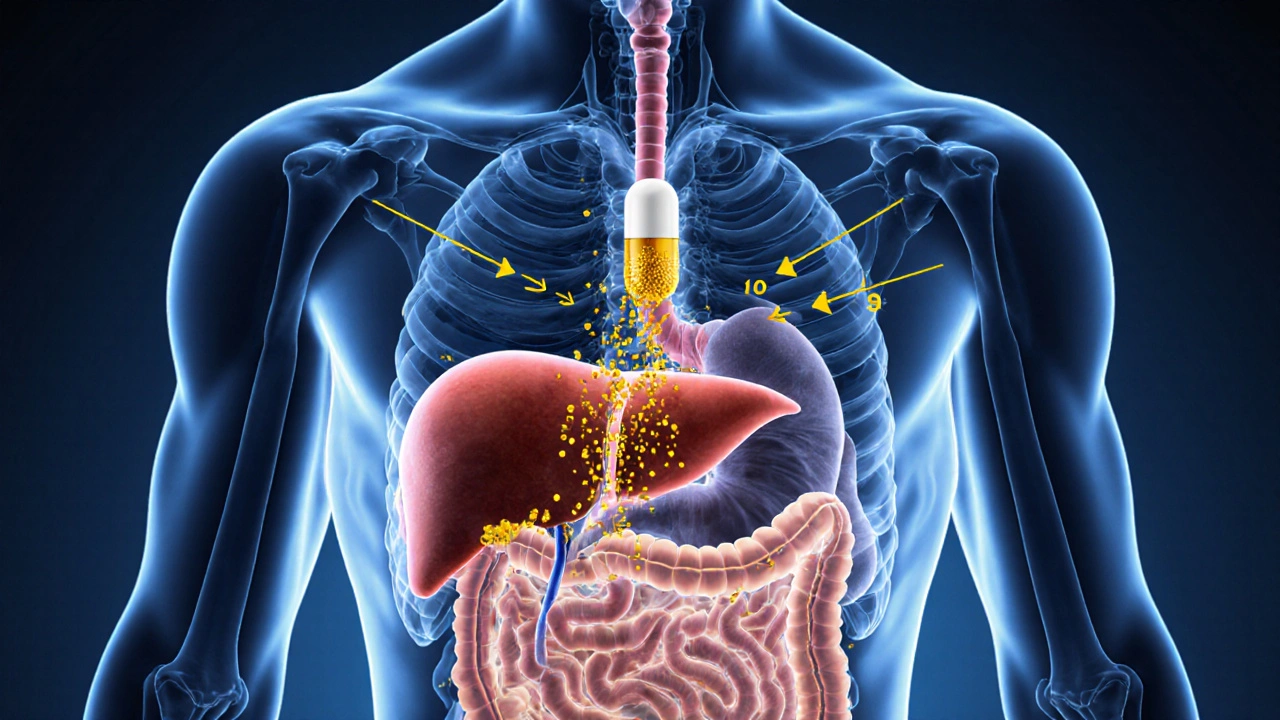 Oct, 13 2025
Oct, 13 2025
Vitamin D Analog Selector
Find Your Best Vitamin D Analogue
Select your medical situation and priorities to get personalized recommendations for the right vitamin D analog.
Recommended Vitamin D Analogue
Key Comparison
Important Considerations
Clinical Guidance
Always consult your healthcare provider before making treatment decisions. This tool provides general guidance based on medical conditions and priorities.
Choosing the right vitamin D analogue can feel like navigating a maze of similar‑sounding names, dosing schedules, and medical conditions. If you’ve been prescribed Alfacip (Alfacalcriol) or are considering it for chronic kidney disease, bone health, or secondary hyperparathyroidism, you’ll want to know how it stacks up against the other options on the market.
Quick Takeaways
- Alfacalcidol is a pro‑drug that needs only one liver conversion step, making it faster than cholecalciferol but slower than calcitriol.
- It shines in chronic kidney disease where the kidneys can’t finish the activation process.
- Calcitriol offers the most immediate effect but carries a higher risk of calcium spikes.
- Cholecalciferol (vitaminD3) is inexpensive and works well for general deficiency but is weak for renal patients.
- Specialized analogues like paricalcitol and doxercalciferol reduce parathyroid hormone with fewer hypercalcaemia events.
What Is Alfacalcidol (Alfacip)?
When you see Alfacalcidol is a synthetic vitaminD3 analogue that requires only a single 25‑hydroxylation step in the liver to become the active hormone calcitriol. In other words, it bypasses the kidney’s final activation step, which is especially useful for patients with renal impairment. Alfacip is the trade name commonly used in Europe and some Asian markets.
How Alfacalcidol Works
After oral ingestion, Alfacalcidol is converted to calcitriol (1,25‑(OH)₂D₃) in the liver. The active calcitriol then binds to vitaminD receptors (VDR) in the intestine, bone, and parathyroid glands, promoting calcium absorption and suppressing parathyroid hormone (PTH) secretion. Its half‑life is roughly 15‑20hours, allowing once‑daily dosing for most patients.

Alternatives at a Glance
Below are the most common alternatives, each introduced with a microdata definition so search engines can recognize them.
Calcitriol is the biologically active form of vitaminD3 that does not require any metabolic activation. It provides the fastest rise in serum calcium but can easily overshoot, especially in patients with limited kidney function.
Cholecalciferol is natural vitaminD3 found in sunlight‑exposed skin and dietary sources; it needs two hydroxylations (liver then kidney) to become active. It’s cheap and widely available, ideal for mild deficiency.
Ergocalciferol is vitaminD2 derived from plant sources; it follows the same activation pathway as cholecalciferol but is less potent. Used when vegan formulations are required.
Paricalcitol is a selective vitaminD receptor activator that suppresses PTH with a lower risk of hypercalcaemia. Often prescribed for secondary hyperparathyroidism in dialysis patients.
Doxercalciferol is a synthetic vitaminD2 analogue that requires liver activation but not renal conversion, making it useful for chronic kidney disease. It’s less potent than calcitriol but safer for calcium balance.
VitaminD deficiency is a condition characterized by low serum 25‑hydroxyvitaminD levels, leading to bone demineralisation and muscle weakness. Treatment choice depends on severity, comorbidities, and renal function.
Chronic kidney disease (CKD) is a progressive loss of kidney function that impairs the final activation step of vitaminD metabolism. Patients often need analogues that bypass renal conversion.
Secondary hyperparathyroidism is excessive PTH secretion triggered by low calcium or vitaminD activity, common in CKD. Controlling PTH is a primary goal of vitaminD analogue therapy.
Side‑by‑Side Comparison
| Analogue | Potency (relative to calcitriol) | Activation steps | Primary indications | Risk of hypercalcaemia | Typical cost (USD/month) |
|---|---|---|---|---|---|
| Alfacalcidol (Alfacip) | ≈0.6‑0.8× | 1‑step (liver) | CKD‑MBD, osteoporosis in renal patients | Medium | $30‑$45 |
| Calcitriol | 1× (reference) | 0‑step (active) | Severe deficiency, hypocalcaemia, renal osteodystrophy | High | $25‑$40 |
| Cholecalciferol | ≈0.1‑0.2× | 2‑step (liver→kidney) | General deficiency, preventive supplementation | Low | $5‑$15 |
| Ergocalciferol | ≈0.08× | 2‑step (liver→kidney) | Vegan deficiency treatment | Low | $8‑$18 |
| Paricalcitol | ≈0.7× | 1‑step (liver) | Secondary hyperparathyroidism in dialysis | Low‑Medium | $70‑$120 |
| Doxercalciferol | ≈0.5× | 1‑step (liver) | CKD‑MBD, PTH control | Low‑Medium | $55‑$90 |
When Alfacalcidol Is the Right Choice
If you have chronic kidney disease stage3‑5 and need to keep PTH in check, Alfacalcidol often wins because it sidesteps the kidney’s broken activation pathway while staying less potent than calcitriol. This balance reduces the chance of a sudden calcium surge that could trigger vascular calcification.
For osteoporosis patients without renal issues, high‑dose cholecalciferol may be enough, but Alfacalcidol can be added when bone density scans show persistent loss despite calcium and bisphosphonate therapy.
When cost is a major factor, Alfacalcidol sits in the mid‑range-cheaper than paricalcitol but pricier than over‑the‑counter vitaminD3. Insurance coverage varies; many EU plans list Alfacip under “bone health agents.”

Pros and Cons
- Pros
- Works in patients with impaired kidney function.
- Once‑daily dosing simplifies adherence.
- Moderate potency reduces hypercalcaemia risk compared with calcitriol.
- Cons
- Not as strong as calcitriol for rapid correction of severe deficiency.
- Requires prescription; not available OTC.
- Potential drug interactions with glucocorticoids and anticonvulsants.
Pitfalls to Avoid
- Skipping baseline labs - always measure serum calcium, phosphate, and PTH before starting.
- Using the same dose for CKD and non‑CKD patients - renal patients often need lower initial doses.
- Ignoring sun exposure - supplementing on top of high endogenous vitaminD can tip calcium upward.
- Failing to monitor every 3‑4weeks during dose adjustments - early detection of hypercalcaemia prevents complications.
Frequently Asked Questions
Can I switch from cholecalciferol to Alfacalcidol?
Yes, but you should first have your doctor check kidney function and serum calcium. Alfacalcidol is more potent, so the dose will be lower than the high‑dose vitaminD3 you might have been taking.
Why is Alfacalcidol preferred in dialysis patients?
Dialysis patients can’t convert vitaminD to its active form because the kidneys are non‑functional. Alfacalcidol only needs a liver step, delivering active hormone without relying on the kidneys.
What side effects should I watch for?
The main concerns are high calcium (hypercalcaemia) and high phosphate (hyperphosphataemia). Symptoms include nausea, weakness, and irregular heartbeat. Regular lab checks catch these early.
How does paricalcitol differ from Alfacalcidol?
Paricalcitol is a selective VDR activator that suppresses PTH while sparing calcium absorption, resulting in a lower hypercalcaemia risk. It’s more expensive and usually reserved for patients on dialysis who need aggressive PTH control.
Is Alfacalcidol safe during pregnancy?
Data are limited, but most guidelines advise using the lowest effective dose only if the benefit clearly outweighs potential risks. Discuss any use with your obstetrician.
Next Steps for Patients and Clinicians
1. Schedule a blood panel that includes calcium, phosphate, 25‑hydroxyvitaminD, and PTH.
2. If the results show CKD‑related deficiency, consider Alfacalcidol as a first‑line prescription.
3. Start with a low dose (e.g., 0.5µg daily) and re‑check labs after 4weeks.
4. Adjust upward or downward based on the trend-aim for PTH within target range without exceeding calcium>10.5mg/dL.
5. Review medication list for interactions (e.g., glucocorticoids, phenytoin).
6. Educate patients on signs of hypercalcaemia and what to do if they occur.
By following this structured approach, you can harness Alfacalcidol’s strengths while avoiding its pitfalls, ensuring bone health and cardiovascular safety for those who need it most.
Herman Rochelle
October 14, 2025 AT 03:00Great overview of the vitamin D analogues; the breakdown makes it easier to decide which option fits a particular clinical scenario. For patients with CKD, remembering that Alfacalcidol only needs liver activation can guide dosing strategies effectively. Also, keeping an eye on calcium and phosphate levels during titration is essential for safety.
Stanley Platt
October 14, 2025 AT 16:53Indeed, the comparative tables furnish a lucid, methodical perspective; however, one must also contemplate reimbursement frameworks, especially within the United States-where insurance coverage varies considerably. Moreover, the pharmacokinetic nuances of each analogue merit meticulous consideration. :)
Alice Settineri
October 15, 2025 AT 06:46Yo, this post slaps! I’ve been juggling Alfacalcidol and paricalcitol like a circus juggler on a unicycle, and let me tell you, the potassium‑calcium tango is wild‑fire intense. If you aren't watching those labs, you might as well be playing roulette with bone health.
Alex Jhonson
October 15, 2025 AT 20:40Totally agree with alicce's point; the liver step is a real game‑changer for CKD patiens. I guess the only thing I keep missin is a better dosing chart-maybe next time?
Katheryn Cochrane
October 16, 2025 AT 10:33The analysis feels surface‑level; it glosses over the fact that many clinicians still prescribe calcitriol out of habit, ignoring newer agents that could reduce hypercalcaemia risk. A more critical appraisal of the cost‑benefit ratio is needed, especially for healthcare systems under budget constraints.
Michael Coakley
October 17, 2025 AT 00:26Ah, the eternal quest for the perfect vitamin D analog-kind of like chasing the meaning of life while tripping over a broken dosage spoon. Sure, Alfacalcidol sounds fancy, but does it really make your calcium levels behave, or are we just playing with fancy chemistry?
ADETUNJI ADEPOJU
October 17, 2025 AT 14:20From an ethical standpoint, the utilization of high‑cost analogues such as paricalcitol must be justified by robust outcome data; otherwise, we risk perpetuating inequitable resource allocation within nephrology practices. The discourse should integrate health economics terminology to ensure policy alignment.
Janae Johnson
October 18, 2025 AT 04:13While the article extols Alfacalcidol's utility, one could argue that the emphasis on cost overlooks the long‑term benefits of reduced cardiovascular calcification associated with lower calcium spikes. Hence, the narrative might be inverted to prioritize clinical outcomes over immediate economics.
Kayla Charles
October 18, 2025 AT 18:06I've spent countless hours poring over the pharmacodynamics of vitamin D analogues, and what strikes me most is the elegant simplicity of Alfacalcidol's single‑step activation in the liver, especially for patients whose renal function is compromised. This single conversion sidesteps the bottleneck of the 1‑α‑hydroxylase enzyme, which is often downregulated in chronic kidney disease, thereby ensuring more predictable serum levels of the active hormone. In practice, this translates to smoother titration curves, fewer episodes of hypercalcaemia, and ultimately a more stable bone‑mineral metabolism. Moreover, the half‑life of approximately 15‑20 hours permits once‑daily dosing, improving adherence compared to agents requiring multiple daily administrations. From a cost perspective, although Alfacalcidol is pricier than over‑the‑counter vitamin D3, it remains substantially less expensive than paricalcitol, positioning it as a cost‑effective bridge therapy. Clinical trials have shown that patients on Alfacalcidol exhibit a modest yet statistically significant reduction in parathyroid hormone levels, which correlates with decreased risk of vascular calcification-a crucial consideration given the high cardiovascular morbidity in CKD cohorts. It's also worth noting that Alfacalcidol's moderate potency offers a safety buffer, reducing the likelihood of abrupt calcium surges that can precipitate arrhythmias. When comparing to calcitriol, the latter's direct activation bypasses hepatic metabolism but carries a heightened hypercalcaemia risk, necessitating vigilant monitoring and often resulting in dose reductions that compromise therapeutic efficacy. In contrast, Alfacalcidol provides a balanced approach, delivering sufficient PTH suppression while maintaining a tolerable calcium profile. For osteoporosis patients without renal impairment, the choice between Alfacalcidol and high‑dose cholecalciferol hinges on the severity of bone loss and the presence of secondary hyperparathyroidism; the former may be preferred when PTH suppression is a therapeutic goal. Finally, patient education remains paramount-ensuring individuals understand the importance of routine lab assessments, potential drug interactions, and adherence to dosing schedules can maximize the benefits of any vitamin D analogue therapy.
Paul Hill II
October 19, 2025 AT 08:00I appreciate the depth of the previous comment; the points about adherence and safety are well taken. It's also useful to remember that laboratory monitoring should be individualized based on baseline values and comorbidities.
Stephanie Colony
October 19, 2025 AT 21:53From a national perspective, adopting Alfacalcidol en masse could signal a commitment to superior bone health standards, yet the discourse often neglects the cultural heritage of traditional vitamin D sources that have sustained populations for centuries.
Abigail Lynch
October 20, 2025 AT 11:46Honestly, the pharmaceutical industry probably pushed these analogues to keep us dependent on costly prescriptions-it's all a grand scheme to monetize our calcium needs while the real cure is just sunlight.
Michele Radford
October 21, 2025 AT 01:40The article fails to address the ethical implications of prescribing expensive analogues in underfunded healthcare settings, thereby perpetuating disparity among patients.
Mangal DUTT Sharma
October 21, 2025 AT 15:33Thank you for this thorough guide! 😊 It really helped me understand why my nephrologist chose Alfacalcidol over other options. The clarity on liver activation versus kidney conversion was especially enlightening. I also appreciate the practical tips on monitoring labs every few weeks; it makes the whole process feel less daunting. Your explanation of cost considerations balanced with efficacy was spot on, and I feel more confident discussing treatment plans with my doctor now. Keep up the excellent work, and please continue sharing such valuable resources! 🙏
Gracee Taylor
October 22, 2025 AT 05:26Well‑written and helpful.
Leslie Woods
October 22, 2025 AT 19:20The focus on liver activation highlights a crucial metabolic step that often gets overlooked in clinical discussions